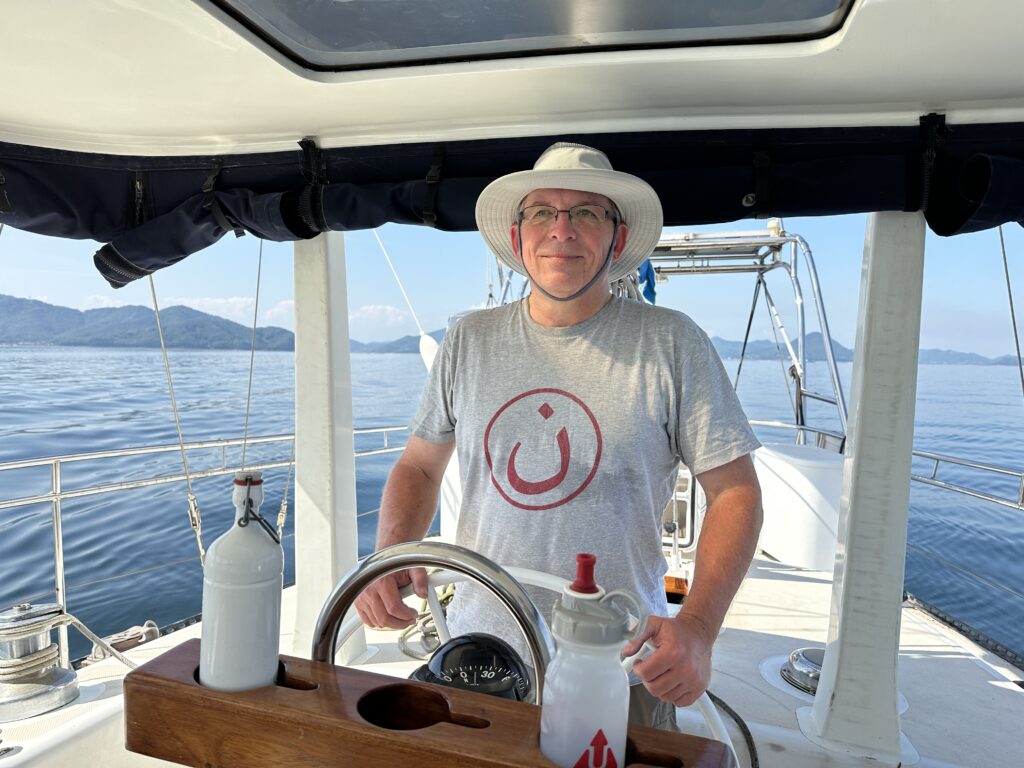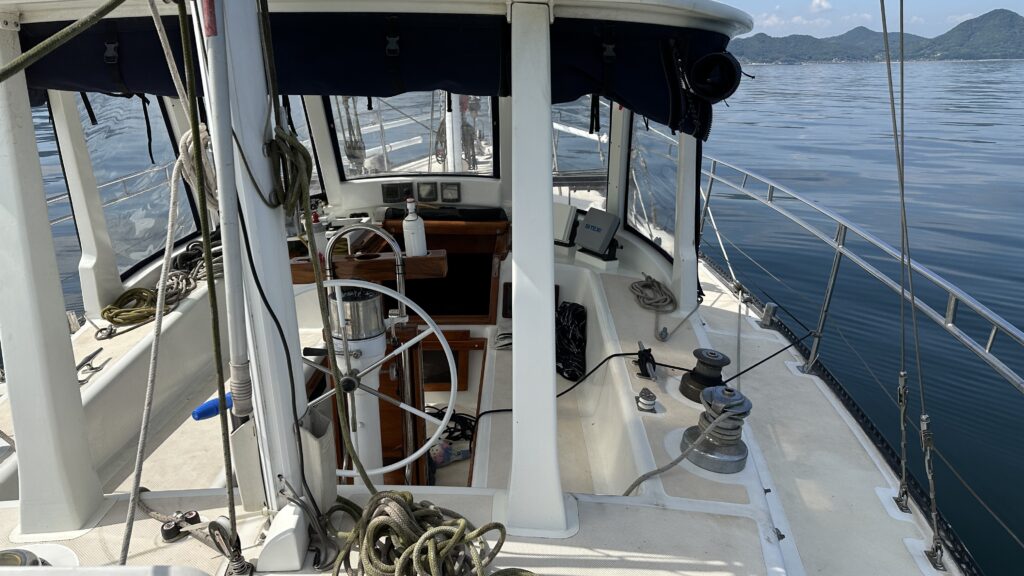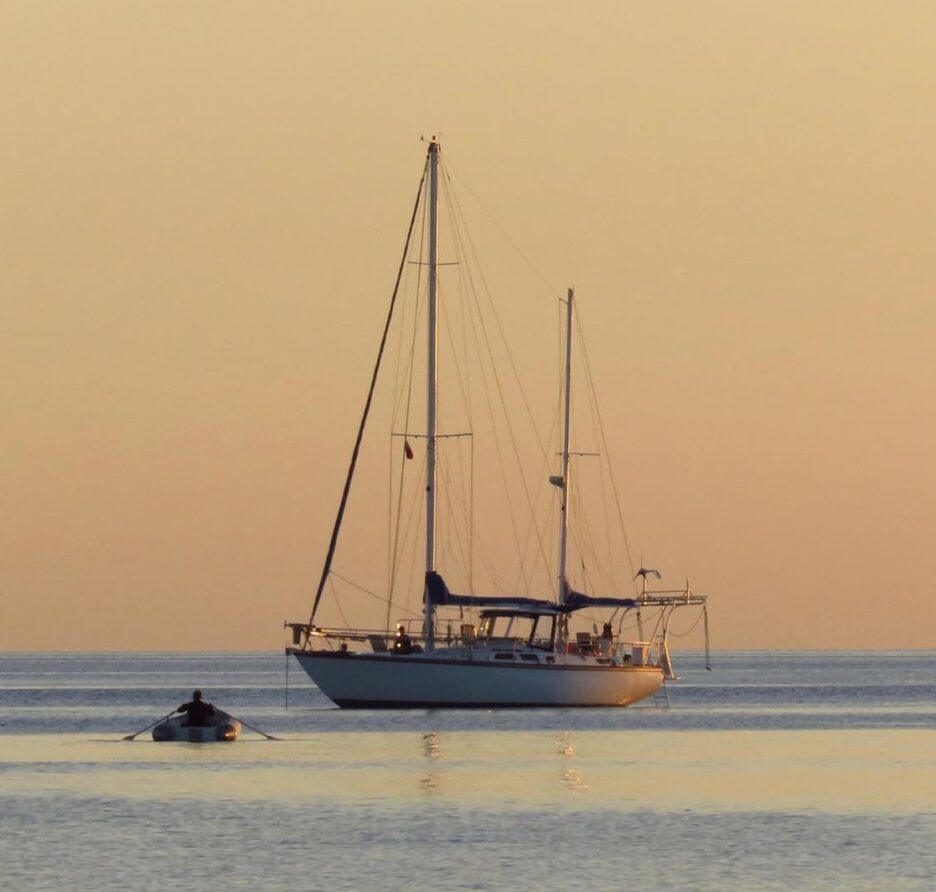I recently returned from a long stretch of back-to-back travel, including four days sailing on a 45 ft ketch in the Seto Inland Sea in Japan. The Big Moooo! is owned by my brother-in-law and sister, who live on Shiraishi Island (Okayama Prefecture), in between Osaka and Hiroshima. The Seto Inland Sea, is a very active shipping corridor which separates three of Japan’s major islands — Honsu, Shkioku, and Kyushu. Osaka Bay is at the eastern edge of the sea. The western edge empties into the Pacific Ocean.
The leading image for this post (above) is our sailboat moored off of Shiraishi Island. The picture below is our vessel in the Seto Inland Sea (with fisherman’s bouys in the distance).

Our home port of Shiraishi Island
Our home port was the fishing village and local vacation island of Shiraishi, which is part of the island chains in the City of Kasaoka. The island is very picturesque and a great place to unplug.
Shiraishijima has two active ports. The Old Port is still the most active by far, and it’s the primary point of embarquement for the numbers ferries and water taxis. I counted about 15-20 active fishing vessels of different types coming and going during my stay. The Big Moooo! – named after the small businesses run on the beach by Paul and Amy – is moored in the new port, which is a short drive (and longer walk) away from the main port.
The original plan was to sail longer, but mechanical problems with the diesel engine ended up keeping us closer to our home port on Shiraishi Island. Nevertheless, despite a likely problem with the water pump used to cool the engine, we achieved two overnights.
The first night we moored off the coast of Tomonoura, about a six-hour sail west in the Sea to watch fireworks set off from the historical Benten Island. We stayed overnight in the channel between Sensui Island and Tomonoura (after a thorough investigation by the Japanese Coast Guard about our intentions). Then, we sailed back to Kitagi Island, visited the stone quarrying museum, and stayed over night in one of the local ports before climbing Mt. Akiba.
Plus I got some experience at the helm as well as seeing the practical side of trying to maintain and operate a larger yacht. This experience was invaluable because I am in the process of determining what kind of sailboat would be best for me as I continue to invest in my sailing journey.
The picture below is me at the helm, just to show that I was one the boat! After the picture are my five takeaways from this excursion about sailing bigger boats.

#1. Larger boats are more stable
One of the first things I noticed was pretty obvious: larger boats are more stable than smaller boats. When I stepped on the ocean-going ketch, I didn’t feel the immediate need to grab onto something unless we were really in open water.

This was different when I sailed smaller boats such as the 22 ft Capri. The boat is always shifting under you feet as the hull adjusts to the weight of the people on board. The boat stabilizes as it gains headway, but a larger person moving forward (or aft) would still move the boat and sometimes require adjustments at the tiller. A 45′ ketch was simply too big for one person moving on the boat to have this effect.
Of course, holding onto something solid and stable, like the main stays, the pilot house, or something else firmly attached to the boat is a good idea. I use the three point rule used in climbing (or walking the aisles of an airplane!)–always have three hands or feet connected to something stable at all times. For example, if I was walking to the bow of the boat, I would have two hands bracing me in someway so one of my feet was always on deck while the other was moving.
#2. Larger boats are a lot of work
Throughout our travels, we mainly sailed with the head sail / jib and mizzen sail out while running the diesel engine. The headsail remained furled. Why? Raising and then managing the mainsail was simply too much work without being fully committed to the open sea. Since our cruises were shorter, and the winds less reliable, managing the jib was easier. We could adjust theses sails more easily, and taking them up and down was much more simple and required less effort.
We cruised with the deisel engine a lot, something we would not necessarily do if we were in open water. The deisel engine provided steady thrust for propulsion, and we adjusted the sails to maximize our speed.
#3. Larger boats need a lot more wind to keep headway
I am not sure why I was surprised by this, but cruising under sail is more weather dependent. When I take the 22′ Capri out, the boat will make headway with just a breath of air. In fact, I have had to sail it back to its slip under canditions are hardly any wind.
Not so much with the bigger boat. The size and weight will mean its needs more wind to keep headway. The benefit of something the size of 45′ boat, of course, is that it can handle almost any sea conditions.
We found that the ketch really needed 8-10 knots of wind just to gain enough headway for the boat to maneuver under sail alone. And then it would be slow, maybe reaching 5-6 knots of speed (about 7 mph). Under 8 knots of wind really needed the diesel engines to keep us moving toward our destination. Fortunately, during our longer overnight cruise, we had decent wind. But we still relied on the diesel engine the entire time to keep us moving at a decent speed.
So, what about those old tall ships, like the ones I feature in my historical fiction pirate series The Pirate of Panther Bay? Well, if you compare the size of the masts, the number and diversity of the sales, and the canvas they can deploy, you can see that the sail-to-hull ratio is very, very high: they have a lot more sail. For some information and insight, look at the specs and description of the sailing brig Niagara at the Erie Maritime Museum. In fact, the USS Constitution, a much bigger frigate, could reach speeds of 13 knots under full sail!
Fun fact: I visited the museum and toured the Niagara to get a better understanding and feel for how this vessel would handle for Isabella and Jean-Michel. In fact, I put together a virtual tour to give visitors and readers and feel for how Isabella’s crew would manage in this floating home. (I encourage anyone with naturical interests to put the Erie Maritime Museum on their travel itinerary.)
#4. Larger sailboats are more complicated
The nice things about smaller boats are less complicated. The smallest, like the one I started out on as a kid, have just one sail. They are great for learning the basics. But as the boat get’s bigger, the more sophisticated the sailor has to be if they want to fully use their vessels capabilities.
When I started taking sailing mmore seriously in 2021, I started out on a 26′ sailboat (a Pearson). I learned how to work the foresail, aka the jib, along with the mainsail. On the 22′ Capri, I was honing these skills with the idea I might at somepoint try a Genoa–a large ballon looking sail that can really catch light winds. The pattener is obvious–bigger boats allow for more complicated sail configuations. They require dedicating and experience to learn how to master them.

With a ketch, a second mast, a mizzen mast, is added to the main mast and all the other sails. As the skipper, you are making more and more adjustements. In addition, monitoring the engines (if they are on) and the other electronics is a constant focus.
My takeaway? I am not ready for a sailboat this big and complicated. I need to stick to the boat size the fits my skill level and allows me to gradually grow into its capabilities.
#5. Larger boats have much better amenities
Offsetting the complications and work are the amentieis that come with a bigger boat. They are far more comfortable. Our 45′ ketch had copious head room, a spacious aft berth with a king size mattress, two very comfortable V-births, two fully enclosed and complete heads (toilet and shower), a full kitchen and galley, and running water. Living on this boat would be easy.

Summing it up
Four days on a bigger vessel than I am used to gave me a lot to think about as I continue my sailing journey. Bigger boats bring more complications and the need to have higher levels of sailing skills. I came away from my four days with a much great apprecation for matching a boat to my skill level. Overreaching with “too much boat” could really create complications and actually limit my progress toward mastering the core skills necessary skipper and enjoy sailing.
Our time on the ketch, however, was great. The amenties allowed us to move easly around the boat, inside or outside. This is a vessel designed for long-haul sailing or making it true second home.
I am looking forward to my next visit to Shiraishi Island and spending more time on this ketch.
